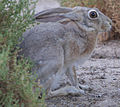Taxonomy[edit]
The Cape hare was one of the many mammal species originally described by Carl Linnaeus in his landmark 1758 10th edition of Systema Naturae, where it was given the binomial name of Lepus capensis.[2]
The taxon is part of a species complex. Lepus tolai and Lepus tibetanus were moved out based on geographic distribution and molecular characteristics. The current remaining grouping of Lepus capensis sensu lato remains paraphyletic.[3]
Description[edit]
The Cape hare is a typical hare, with well-developed legs for leaping and running, and large eyes and ears to look for threats from its environment. Usually, a white ring surrounds the eye. It has a fine, soft coat which varies in colour from light brown to reddish to sandy grey. Unusually among mammals, the female is larger than the male, an example of sexual dimorphism.
Distribution and habitat[edit]
The Cape hare inhabits macchia-type vegetation, grassland, bushveld, the Sahara Desert and semi-desert areas. It is also common in parts of the Ethiopian highlands, such as Degua Tembien.[4]
Breeding[edit]
After a 42-day-long pregnancy, the female gives birth to from one to three young, termed leverets, per litter and may have as many as 4 litters per year. A characteristic of hares which differentiates them from rabbits is that the young are born precocial; that is, the young are born with eyes open and are able to move about shortly after birth. The Cape hare is no exception in this regard.
Currently, 12 subspecies are recognised:[6]

